East Timor Solar Project: Analysis of Execution, Risks, and Costs
VerifiedAdded on 2023/06/08
|8
|1342
|398
Report
AI Summary
This report analyzes the East Timor Solar Project, focusing on its project execution plan designed to bring electricity to 12,000 villagers via solar panels funded by Google. It details key aspects of the execution plan, including the project's purpose and scope, encompassing feasibility analysis, due diligence, RFP, bidding, conceptual designing, technology analysis, procurement management, contract development, cost management, risk management, and safety management. The report further elaborates on cost management strategies, highlighting budget allocation and financial resource disbursal based on milestones. A significant portion is dedicated to risk management, outlining the identification, analysis, planning, and mitigation of potential risks such as insufficient solar systems, language barriers, and weather disruptions. The procurement strategies for vendors and consultants are also discussed, along with the definition of project resources, roles, and skills needed for effective implementation. The report concludes by emphasizing the importance of a project execution plan for streamlining project implementation and maintaining quality standards.
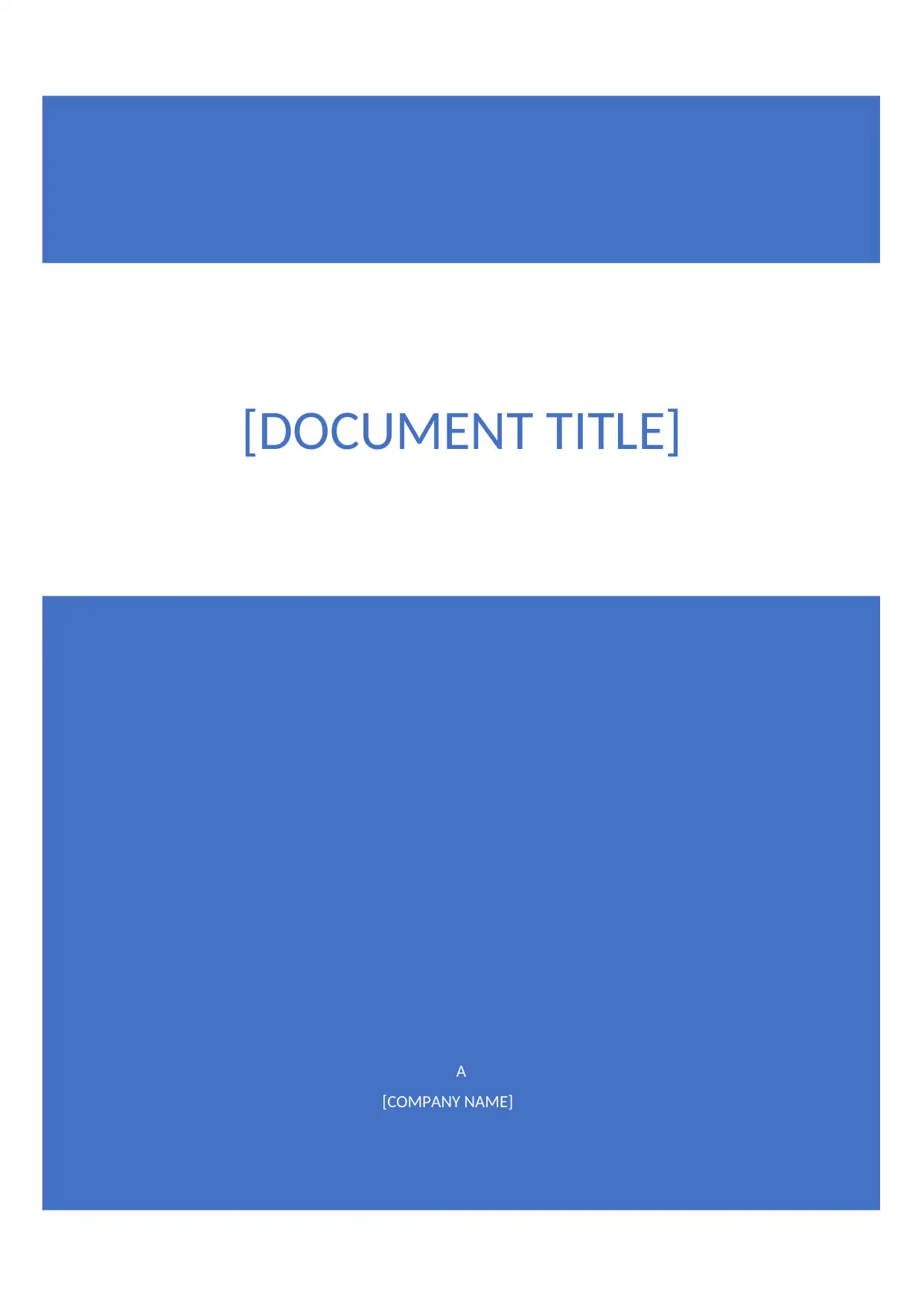
A
[COMPANY NAME]
[DOCUMENT TITLE]
[COMPANY NAME]
[DOCUMENT TITLE]
Paraphrase This Document
Need a fresh take? Get an instant paraphrase of this document with our AI Paraphraser

Contents
Introduction................................................................................................................................1
Project Execution Plan...............................................................................................................1
Cost Management...................................................................................................................1
Risk Management.......................................................................................................................2
Procurement............................................................................................................................4
Conclusion..............................................................................................................................4
Introduction................................................................................................................................1
Project Execution Plan...............................................................................................................1
Cost Management...................................................................................................................1
Risk Management.......................................................................................................................2
Procurement............................................................................................................................4
Conclusion..............................................................................................................................4
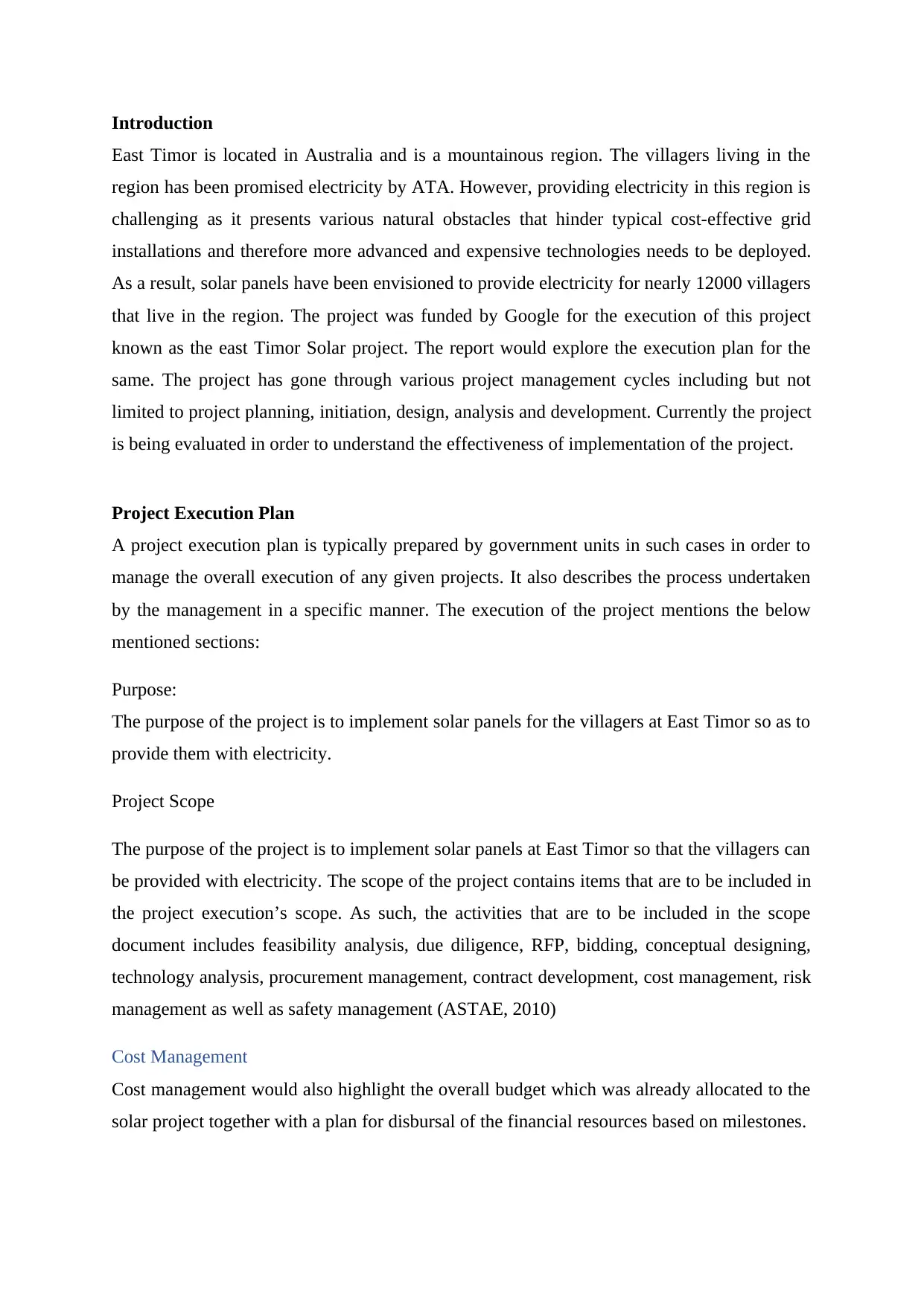
Introduction
East Timor is located in Australia and is a mountainous region. The villagers living in the
region has been promised electricity by ATA. However, providing electricity in this region is
challenging as it presents various natural obstacles that hinder typical cost-effective grid
installations and therefore more advanced and expensive technologies needs to be deployed.
As a result, solar panels have been envisioned to provide electricity for nearly 12000 villagers
that live in the region. The project was funded by Google for the execution of this project
known as the east Timor Solar project. The report would explore the execution plan for the
same. The project has gone through various project management cycles including but not
limited to project planning, initiation, design, analysis and development. Currently the project
is being evaluated in order to understand the effectiveness of implementation of the project.
Project Execution Plan
A project execution plan is typically prepared by government units in such cases in order to
manage the overall execution of any given projects. It also describes the process undertaken
by the management in a specific manner. The execution of the project mentions the below
mentioned sections:
Purpose:
The purpose of the project is to implement solar panels for the villagers at East Timor so as to
provide them with electricity.
Project Scope
The purpose of the project is to implement solar panels at East Timor so that the villagers can
be provided with electricity. The scope of the project contains items that are to be included in
the project execution’s scope. As such, the activities that are to be included in the scope
document includes feasibility analysis, due diligence, RFP, bidding, conceptual designing,
technology analysis, procurement management, contract development, cost management, risk
management as well as safety management (ASTAE, 2010)
Cost Management
Cost management would also highlight the overall budget which was already allocated to the
solar project together with a plan for disbursal of the financial resources based on milestones.
East Timor is located in Australia and is a mountainous region. The villagers living in the
region has been promised electricity by ATA. However, providing electricity in this region is
challenging as it presents various natural obstacles that hinder typical cost-effective grid
installations and therefore more advanced and expensive technologies needs to be deployed.
As a result, solar panels have been envisioned to provide electricity for nearly 12000 villagers
that live in the region. The project was funded by Google for the execution of this project
known as the east Timor Solar project. The report would explore the execution plan for the
same. The project has gone through various project management cycles including but not
limited to project planning, initiation, design, analysis and development. Currently the project
is being evaluated in order to understand the effectiveness of implementation of the project.
Project Execution Plan
A project execution plan is typically prepared by government units in such cases in order to
manage the overall execution of any given projects. It also describes the process undertaken
by the management in a specific manner. The execution of the project mentions the below
mentioned sections:
Purpose:
The purpose of the project is to implement solar panels for the villagers at East Timor so as to
provide them with electricity.
Project Scope
The purpose of the project is to implement solar panels at East Timor so that the villagers can
be provided with electricity. The scope of the project contains items that are to be included in
the project execution’s scope. As such, the activities that are to be included in the scope
document includes feasibility analysis, due diligence, RFP, bidding, conceptual designing,
technology analysis, procurement management, contract development, cost management, risk
management as well as safety management (ASTAE, 2010)
Cost Management
Cost management would also highlight the overall budget which was already allocated to the
solar project together with a plan for disbursal of the financial resources based on milestones.
⊘ This is a preview!⊘
Do you want full access?
Subscribe today to unlock all pages.

Trusted by 1+ million students worldwide
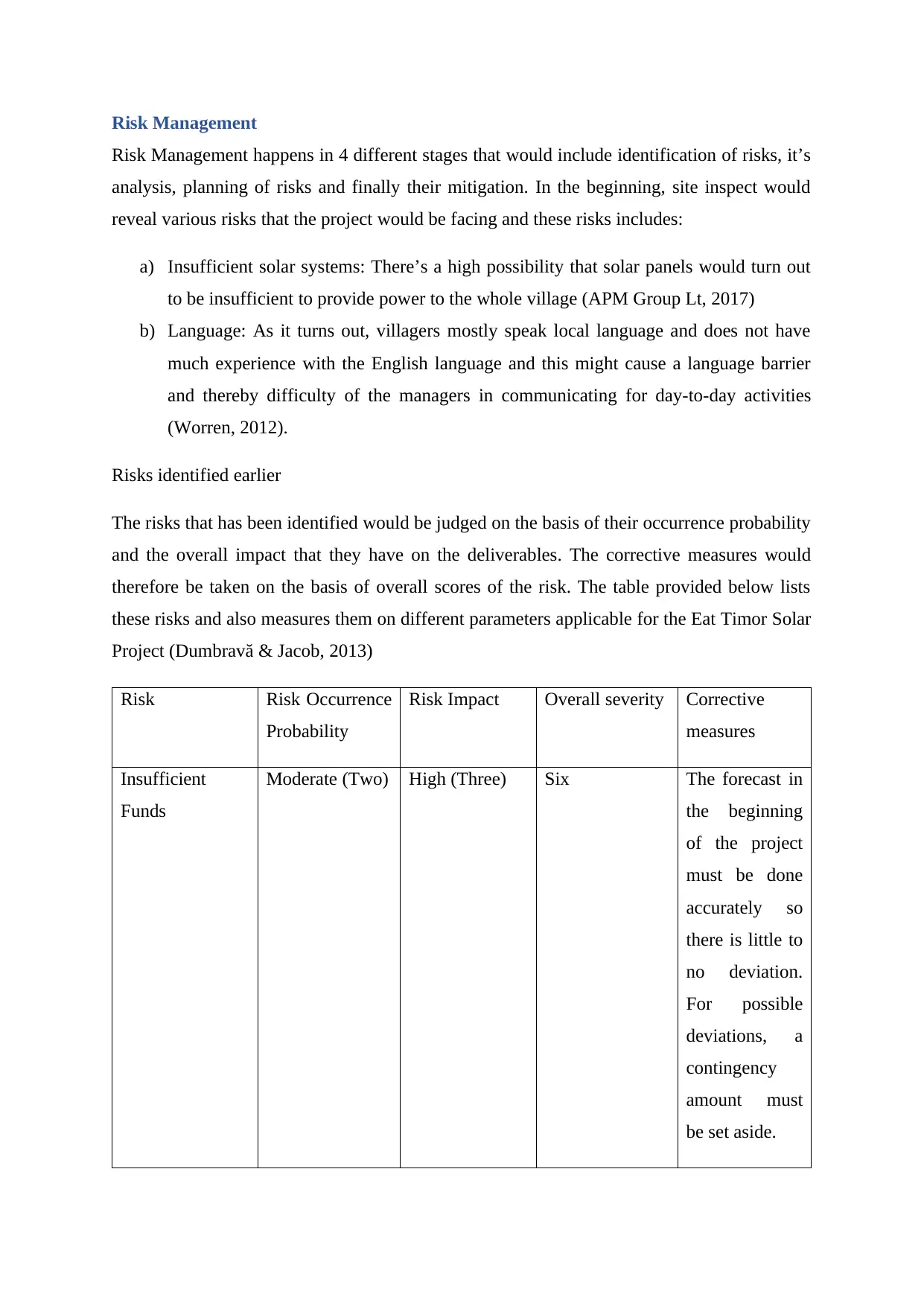
Risk Management
Risk Management happens in 4 different stages that would include identification of risks, it’s
analysis, planning of risks and finally their mitigation. In the beginning, site inspect would
reveal various risks that the project would be facing and these risks includes:
a) Insufficient solar systems: There’s a high possibility that solar panels would turn out
to be insufficient to provide power to the whole village (APM Group Lt, 2017)
b) Language: As it turns out, villagers mostly speak local language and does not have
much experience with the English language and this might cause a language barrier
and thereby difficulty of the managers in communicating for day-to-day activities
(Worren, 2012).
Risks identified earlier
The risks that has been identified would be judged on the basis of their occurrence probability
and the overall impact that they have on the deliverables. The corrective measures would
therefore be taken on the basis of overall scores of the risk. The table provided below lists
these risks and also measures them on different parameters applicable for the Eat Timor Solar
Project (Dumbravă & Jacob, 2013)
Risk Risk Occurrence
Probability
Risk Impact Overall severity Corrective
measures
Insufficient
Funds
Moderate (Two) High (Three) Six The forecast in
the beginning
of the project
must be done
accurately so
there is little to
no deviation.
For possible
deviations, a
contingency
amount must
be set aside.
Risk Management happens in 4 different stages that would include identification of risks, it’s
analysis, planning of risks and finally their mitigation. In the beginning, site inspect would
reveal various risks that the project would be facing and these risks includes:
a) Insufficient solar systems: There’s a high possibility that solar panels would turn out
to be insufficient to provide power to the whole village (APM Group Lt, 2017)
b) Language: As it turns out, villagers mostly speak local language and does not have
much experience with the English language and this might cause a language barrier
and thereby difficulty of the managers in communicating for day-to-day activities
(Worren, 2012).
Risks identified earlier
The risks that has been identified would be judged on the basis of their occurrence probability
and the overall impact that they have on the deliverables. The corrective measures would
therefore be taken on the basis of overall scores of the risk. The table provided below lists
these risks and also measures them on different parameters applicable for the Eat Timor Solar
Project (Dumbravă & Jacob, 2013)
Risk Risk Occurrence
Probability
Risk Impact Overall severity Corrective
measures
Insufficient
Funds
Moderate (Two) High (Three) Six The forecast in
the beginning
of the project
must be done
accurately so
there is little to
no deviation.
For possible
deviations, a
contingency
amount must
be set aside.
Paraphrase This Document
Need a fresh take? Get an instant paraphrase of this document with our AI Paraphraser
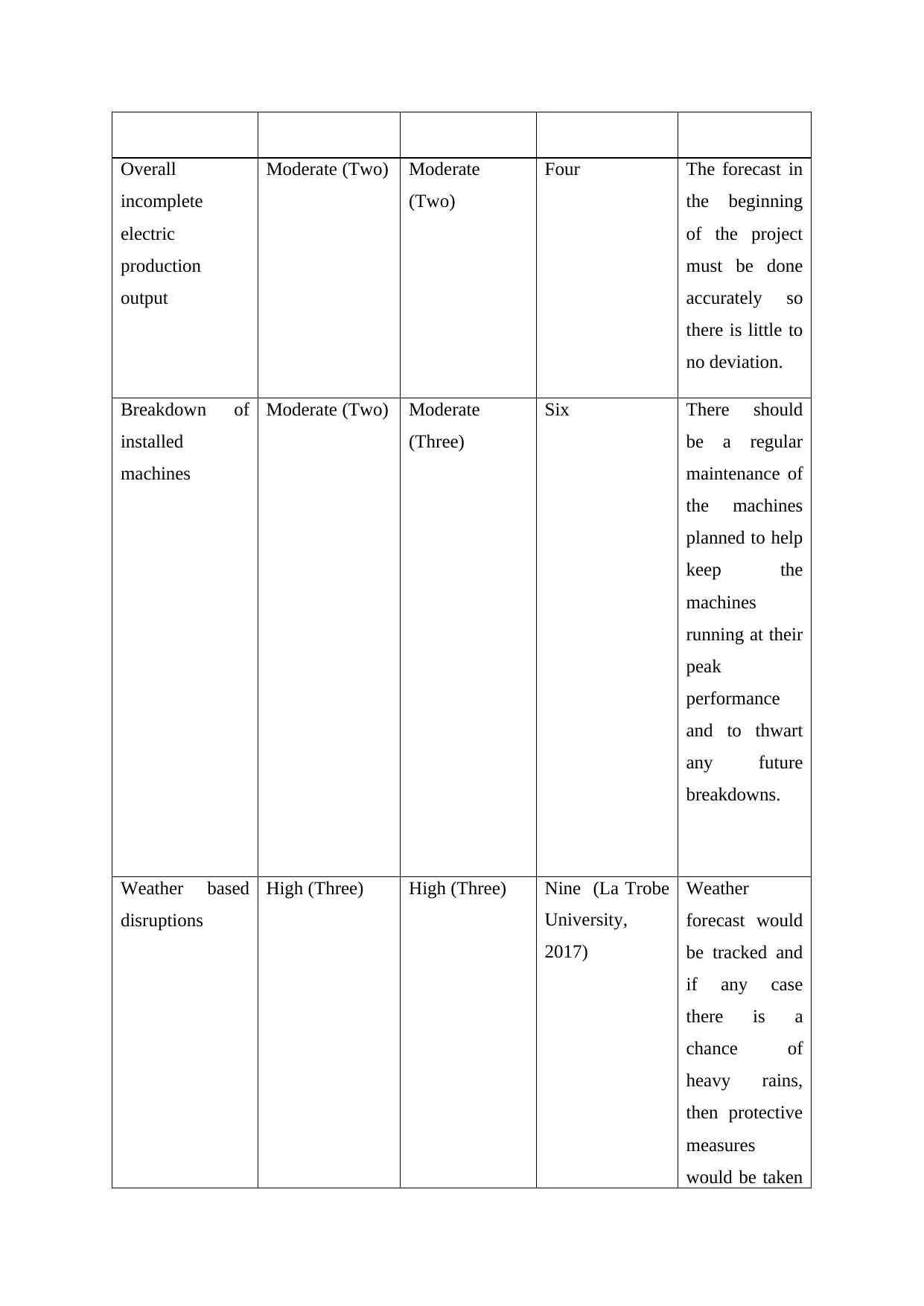
Overall
incomplete
electric
production
output
Moderate (Two) Moderate
(Two)
Four The forecast in
the beginning
of the project
must be done
accurately so
there is little to
no deviation.
Breakdown of
installed
machines
Moderate (Two) Moderate
(Three)
Six There should
be a regular
maintenance of
the machines
planned to help
keep the
machines
running at their
peak
performance
and to thwart
any future
breakdowns.
Weather based
disruptions
High (Three) High (Three) Nine (La Trobe
University,
2017)
Weather
forecast would
be tracked and
if any case
there is a
chance of
heavy rains,
then protective
measures
would be taken
incomplete
electric
production
output
Moderate (Two) Moderate
(Two)
Four The forecast in
the beginning
of the project
must be done
accurately so
there is little to
no deviation.
Breakdown of
installed
machines
Moderate (Two) Moderate
(Three)
Six There should
be a regular
maintenance of
the machines
planned to help
keep the
machines
running at their
peak
performance
and to thwart
any future
breakdowns.
Weather based
disruptions
High (Three) High (Three) Nine (La Trobe
University,
2017)
Weather
forecast would
be tracked and
if any case
there is a
chance of
heavy rains,
then protective
measures
would be taken
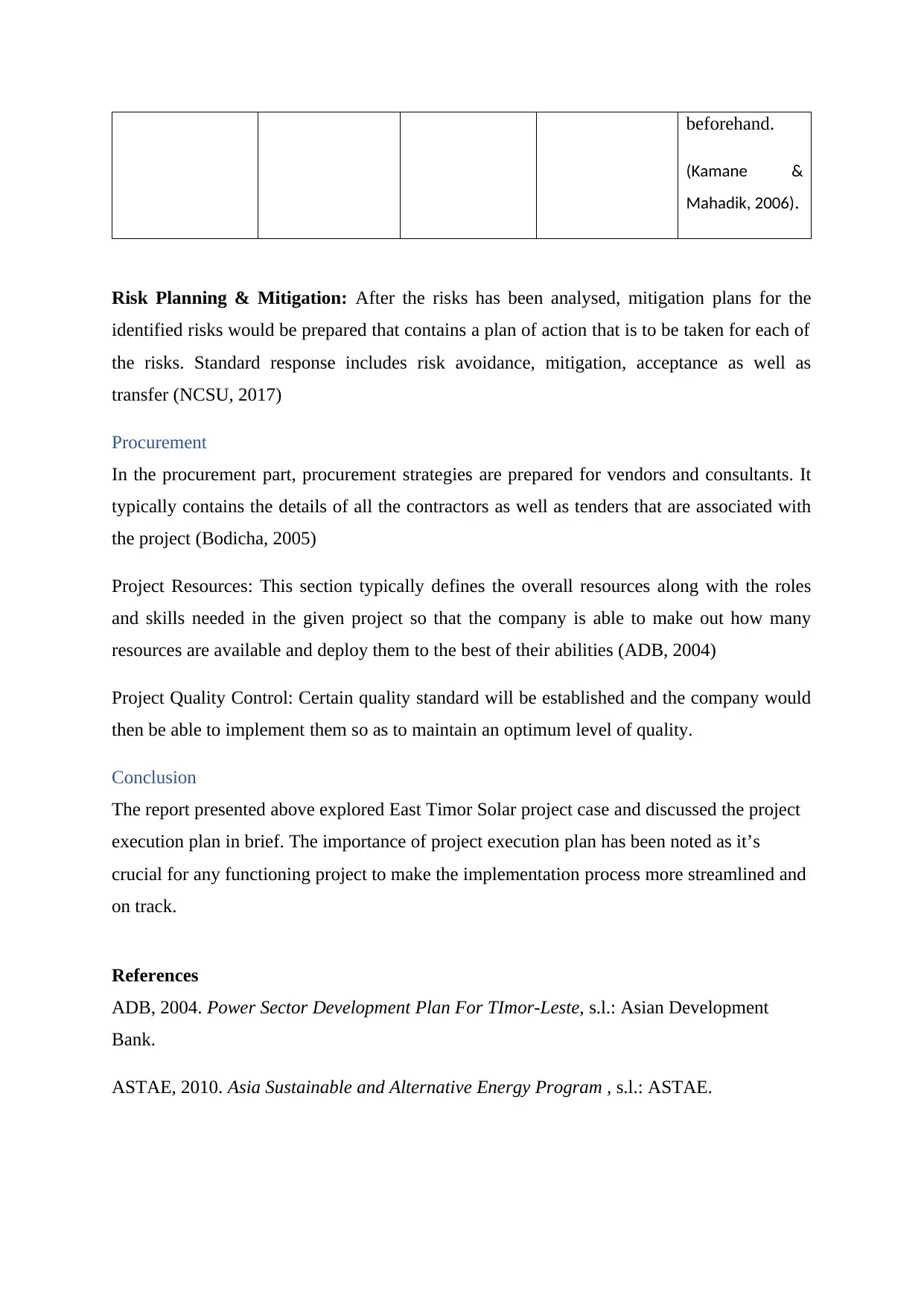
beforehand.
(Kamane &
Mahadik, 2006).
Risk Planning & Mitigation: After the risks has been analysed, mitigation plans for the
identified risks would be prepared that contains a plan of action that is to be taken for each of
the risks. Standard response includes risk avoidance, mitigation, acceptance as well as
transfer (NCSU, 2017)
Procurement
In the procurement part, procurement strategies are prepared for vendors and consultants. It
typically contains the details of all the contractors as well as tenders that are associated with
the project (Bodicha, 2005)
Project Resources: This section typically defines the overall resources along with the roles
and skills needed in the given project so that the company is able to make out how many
resources are available and deploy them to the best of their abilities (ADB, 2004)
Project Quality Control: Certain quality standard will be established and the company would
then be able to implement them so as to maintain an optimum level of quality.
Conclusion
The report presented above explored East Timor Solar project case and discussed the project
execution plan in brief. The importance of project execution plan has been noted as it’s
crucial for any functioning project to make the implementation process more streamlined and
on track.
References
ADB, 2004. Power Sector Development Plan For TImor-Leste, s.l.: Asian Development
Bank.
ASTAE, 2010. Asia Sustainable and Alternative Energy Program , s.l.: ASTAE.
(Kamane &
Mahadik, 2006).
Risk Planning & Mitigation: After the risks has been analysed, mitigation plans for the
identified risks would be prepared that contains a plan of action that is to be taken for each of
the risks. Standard response includes risk avoidance, mitigation, acceptance as well as
transfer (NCSU, 2017)
Procurement
In the procurement part, procurement strategies are prepared for vendors and consultants. It
typically contains the details of all the contractors as well as tenders that are associated with
the project (Bodicha, 2005)
Project Resources: This section typically defines the overall resources along with the roles
and skills needed in the given project so that the company is able to make out how many
resources are available and deploy them to the best of their abilities (ADB, 2004)
Project Quality Control: Certain quality standard will be established and the company would
then be able to implement them so as to maintain an optimum level of quality.
Conclusion
The report presented above explored East Timor Solar project case and discussed the project
execution plan in brief. The importance of project execution plan has been noted as it’s
crucial for any functioning project to make the implementation process more streamlined and
on track.
References
ADB, 2004. Power Sector Development Plan For TImor-Leste, s.l.: Asian Development
Bank.
ASTAE, 2010. Asia Sustainable and Alternative Energy Program , s.l.: ASTAE.
⊘ This is a preview!⊘
Do you want full access?
Subscribe today to unlock all pages.

Trusted by 1+ million students worldwide
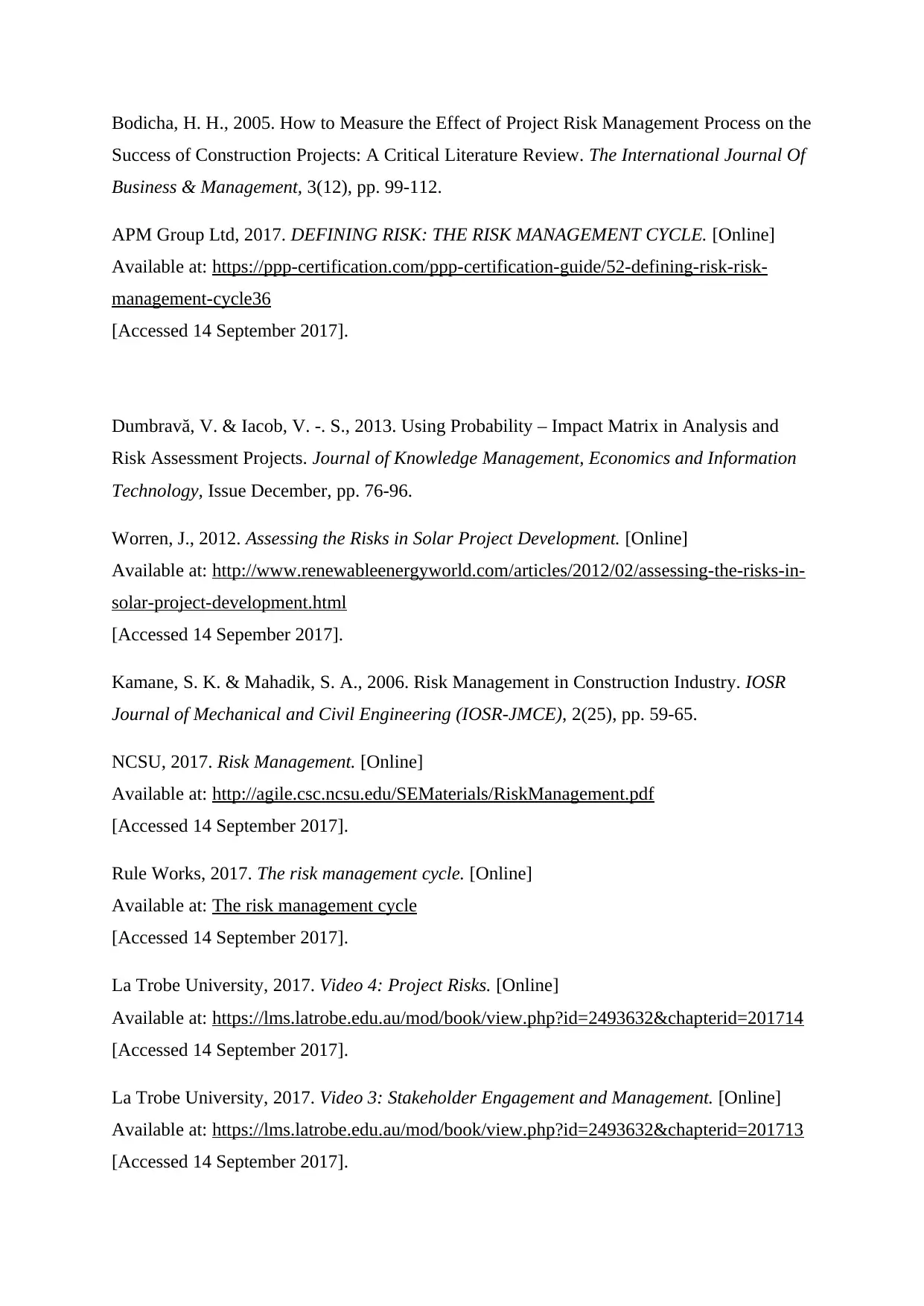
Bodicha, H. H., 2005. How to Measure the Effect of Project Risk Management Process on the
Success of Construction Projects: A Critical Literature Review. The International Journal Of
Business & Management, 3(12), pp. 99-112.
APM Group Ltd, 2017. DEFINING RISK: THE RISK MANAGEMENT CYCLE. [Online]
Available at: https://ppp-certification.com/ppp-certification-guide/52-defining-risk-risk-
management-cycle36
[Accessed 14 September 2017].
Dumbravă, V. & Iacob, V. -. S., 2013. Using Probability – Impact Matrix in Analysis and
Risk Assessment Projects. Journal of Knowledge Management, Economics and Information
Technology, Issue December, pp. 76-96.
Worren, J., 2012. Assessing the Risks in Solar Project Development. [Online]
Available at: http://www.renewableenergyworld.com/articles/2012/02/assessing-the-risks-in-
solar-project-development.html
[Accessed 14 Sepember 2017].
Kamane, S. K. & Mahadik, S. A., 2006. Risk Management in Construction Industry. IOSR
Journal of Mechanical and Civil Engineering (IOSR-JMCE), 2(25), pp. 59-65.
NCSU, 2017. Risk Management. [Online]
Available at: http://agile.csc.ncsu.edu/SEMaterials/RiskManagement.pdf
[Accessed 14 September 2017].
Rule Works, 2017. The risk management cycle. [Online]
Available at: The risk management cycle
[Accessed 14 September 2017].
La Trobe University, 2017. Video 4: Project Risks. [Online]
Available at: https://lms.latrobe.edu.au/mod/book/view.php?id=2493632&chapterid=201714
[Accessed 14 September 2017].
La Trobe University, 2017. Video 3: Stakeholder Engagement and Management. [Online]
Available at: https://lms.latrobe.edu.au/mod/book/view.php?id=2493632&chapterid=201713
[Accessed 14 September 2017].
Success of Construction Projects: A Critical Literature Review. The International Journal Of
Business & Management, 3(12), pp. 99-112.
APM Group Ltd, 2017. DEFINING RISK: THE RISK MANAGEMENT CYCLE. [Online]
Available at: https://ppp-certification.com/ppp-certification-guide/52-defining-risk-risk-
management-cycle36
[Accessed 14 September 2017].
Dumbravă, V. & Iacob, V. -. S., 2013. Using Probability – Impact Matrix in Analysis and
Risk Assessment Projects. Journal of Knowledge Management, Economics and Information
Technology, Issue December, pp. 76-96.
Worren, J., 2012. Assessing the Risks in Solar Project Development. [Online]
Available at: http://www.renewableenergyworld.com/articles/2012/02/assessing-the-risks-in-
solar-project-development.html
[Accessed 14 Sepember 2017].
Kamane, S. K. & Mahadik, S. A., 2006. Risk Management in Construction Industry. IOSR
Journal of Mechanical and Civil Engineering (IOSR-JMCE), 2(25), pp. 59-65.
NCSU, 2017. Risk Management. [Online]
Available at: http://agile.csc.ncsu.edu/SEMaterials/RiskManagement.pdf
[Accessed 14 September 2017].
Rule Works, 2017. The risk management cycle. [Online]
Available at: The risk management cycle
[Accessed 14 September 2017].
La Trobe University, 2017. Video 4: Project Risks. [Online]
Available at: https://lms.latrobe.edu.au/mod/book/view.php?id=2493632&chapterid=201714
[Accessed 14 September 2017].
La Trobe University, 2017. Video 3: Stakeholder Engagement and Management. [Online]
Available at: https://lms.latrobe.edu.au/mod/book/view.php?id=2493632&chapterid=201713
[Accessed 14 September 2017].
Paraphrase This Document
Need a fresh take? Get an instant paraphrase of this document with our AI Paraphraser

1 out of 8
Related Documents
Your All-in-One AI-Powered Toolkit for Academic Success.
+13062052269
info@desklib.com
Available 24*7 on WhatsApp / Email
![[object Object]](/_next/static/media/star-bottom.7253800d.svg)
Unlock your academic potential
Copyright © 2020–2025 A2Z Services. All Rights Reserved. Developed and managed by ZUCOL.




